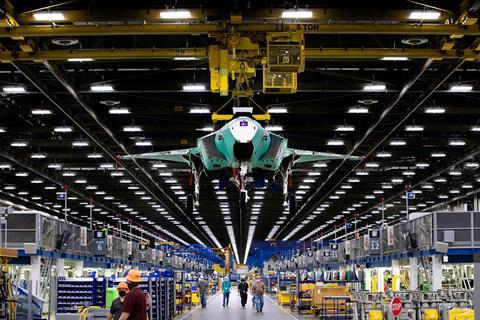Defence aerospace manufacturer Lockheed Martin says it is currently flight testing the long awaited Technical Refresh-3 (TR-3) communications upgrade to its prolific F-35 Lightning II fighter jet.
Lockheed chief executive Jim Taiclet described the process of rolling out TR-3 as being in the “very late innings” during an 18 April earnings call with investors.

“There have been some delays in some of the hardware and software, but we’re really in the very late innings of getting this all together,” he notes. “We’re literally flight testing right now.”
TR-3 is intended to radically improve the F-35’s already-powerful suite of onboard communications and data processing systems. The goal is to turn each jet into a battlefield node for collecting and distributing information during combat.
“TR-3 is the F-35’s critical computer processing electronics upgrade that will continue to provide all our pilots with the capability they need to be successful against any adversary,” said US Air Force Lieutenant General Mike Schmidt in January, when the first TR-3 test flight launched.
According to the Pentagon, the improvements will enable new sensor suites, more long-range precision weapons, improved electronic warfare features and more powerful data fusion.
“These capabilities provide the war fighter a combat edge to identify, track, engage, and survive against advanced air, ground and cyber threats,” the Pentagon’s F-35 Joint Program Office says.
“It gives us a much, much greater capability to really make the F-35 a true edge compute node,” Taiclet confirms.
The TR-3 package will turn the F-35 into an airborne data centre capable of operating at 5G speeds. Taiclet notes there are three main elements to accomplishing that: onboard data storage, computer processing power, and the ability to transmit that data back to friendly networks through multiple pathways.
“The TR-3 upgrade provides all that,” he says, adding that Lockheed plans to roll out the new TR-3 upgrade in Lot 15 F-35s.
“I would consider this an extremely high-degree of difficulty,” Taiclet says of the project. “We’re going to make sure that it’s done right.”
He describes TR-3 as being comprised of “a number” of intricate components and sub-components that are “fairly leading-edge for the aerospace industry”.
Taiclet did not offer a firm schedule for when the TR-3 improvements would be ready to roll out, saying that will depend on the outcome of the current certification effort and consultations with the Pentagon.
“We’ve got to see what the test results are,” Taiclet notes.
Overall, he expresses a high level of confidence in the health of the F-35 programme and customer interest around the world.
“Demand for the aircraft, both from the US and international customers, really has blossomed,” Taiclet says. “I think we’re in good shape on the programme.”
Lockheed says it has delivered more than 900 F-35 airframes, as of April. That would make the F-35 the fourth most-common combat fighter in the world, after the Lockheed F-16 strike fighter, Sukhoi Su-27/30/34/35 family and the Boeing F-15 air superiority fighter.
Twelve military services from nine countries have declared their planned F-35 fleets to be at initial operational capacity.


























